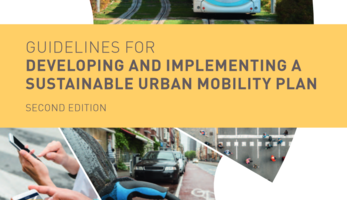Guidelines for developing and implementing a Sustainable Urban Mobility Plan (SUMP)
Basic Information
Language
English
Latest update
Price
Free
Tool type
Guidance document / Manual Method / Approach
Application area
- Data gathering
- Analysis, scenarios and measure selection
- Appraisal and assessment
- Financing, procurement, legal aspects, measure implementation
- Evaluation and monitoring
- Dissemination and communication
- Exploitation and business plans
Target Audience
- Rural areas
- Small cities
- Medium-sized cities
- Large cities
- Metropolitan regions
Summary
What is Sustainable Urban Mobility Planning (SUMP)?
SUMP a strategic and integrated approach to urban transport. It contributes to improved accessibility and quality of life through a shift towards sustainable mobility. SUMP supports fact-based decision making guided by a long-term vision. This requires a thorough assessment of the status quo and future trends, a common vision with strategic objectives, and an integrated set of measures from different policy areas, including regulation, promotion, financing, technology and infrastructure. The SUMP concept places particular emphasis on the involvement of citizens and stakeholders and on the cooperation among actors in public administrations and with the private sector. Sustainable Urban Mobility Planning sets the new standard for innovative transport planning. It helps cities and regions integrate transport modes and encourage sustainable mobility. SUMPs contribute to realising key mobility goals, such as better air quality, improved accessibility and mobility, increased road safety, decreased traffic noise, higher energy efficiency, and enhanced quality of life. SUMP helps cities and regions to reduce their climate impact from transport.
The SUMP Guidelines
The second edition of the Guidelines for developing and implementing a Sustainable Urban Mobility Plan guides practitioners and decision-makers through how to develop and implement a SUMP using a step by step approach. This is complemented by a range of recommendations regarding tools, methods and good practice examples from cities all over Europe. Whilst the SUMP concept and its eight fundamental principles have stayed the same since the first edition of the SUMP Guidelines, the recommended process for achieving them has been updated and improved. The new Guidelines offer clear systematic advice but highlight the flexibility of the process and the importance of adaptation to the local and national context. They provide more support for important horizontal aspects, such as citizen engagement, political decision making and monitoring. To make the document as hands-on and practically useful as possible, good practice examples and planning tools are heavily featured in the update. More than 60 examples from cities all over Europe give inspiration on what SUMPs can look like in practice. Although the document was primarily developed with planners and decision-makers in mind, it also contains a comprehensive introduction to sustainable urban mobility planning for those with less knowledge of the topic, including an updated description of its benefits.
Good Example
See the Annex to the SUMP Guidelines for more than 60 Good Practice Examples from cities all over Europe: https://www.eltis.org/sites/default/files/sump-annex_final_highres_0.pdf







